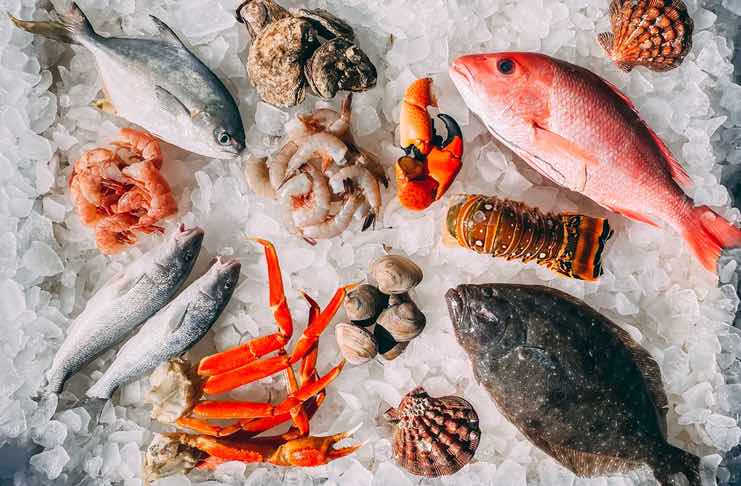Imagine a well-lit kitchen, the soft clinks of pans, and the rich aroma of delicious seafood wafting through the air. At the heart of every great dish lies a secret – a precise blend of technique, timing, and the finest ingredients.
When it comes to seafood, there’s an age-old debate lurking beneath the surface: the matter of fresh vs frozen seafood. How does one handle frozen seafood to create a dish that is just as tantalizing and rich in flavor as one made with fresh catch? Stick around as we dive deep into this intriguing topic. We will delve into various techniques, the magic of seasoning, the art of thawing, and the wonders of cooking to perfection.
The Gentle Art of Thawing: Unlocking Seafood’s True Potential
Seafood is sensitive. Hence, the thawing process demands patience and understanding. Think of thawing as the prelude to a grand symphony. Do it right, and the notes that follow will be harmonious and delightful. Now, one could argue that fresh seafood bypasses this step, but the treasures that lie frozen beneath icy layers have their own allure. Here’s the technique for thawing frozen seafood perfectly:
- Refrigerator Thawing: For those planning a seafood feast, this method is ideal. Place the frozen seafood in a leak-proof plastic bag and leave it in the refrigerator. A pound of seafood will typically take a day to thaw. This method ensures even thawing and maintains texture.
- Cold Water Thawing: For those on a tighter schedule, immerse the leak-proof plastic bag in cold tap water, changing the water every 30 minutes. Most seafood packages will thaw in an hour or less using this technique.
While using fresh seafood might allow you to skip this step, frozen seafood, when thawed correctly, maintains its rich flavor and offers a texture that’s equally inviting.
Marinating Magic: Infusing Flavors Deep Within
Ah, the beauty of a good marinade! The flavors seeping deep into the seafood, creating a symphony of taste that’s nothing short of a culinary masterpiece. Whether it’s the spicy kick of chili or the tartness of lemon, marinating frozen seafood can make all the difference.
For the chefs who swear by fresh seafood, consider this: frozen seafood, having been preserved at its peak, can often absorb flavors more readily, adding layers to the dish. Start with a base of olive oil or melted butter, throw in herbs and spices of your choice, and let the seafood soak in this concoction. A good 30 minutes is all it takes for the flavors to infuse.
Cooking Chronicles: Getting the Temperature Just Right
Cooking seafood, especially when it’s frozen, is a dance between temperature and time. It’s essential to get both just right to unlock the full potential of the dish. Whether you’re grilling, steaming, or frying, here are a few tips to remember:
- Pan Frying: Opt for a heavy skillet or a non-stick pan. Once it’s hot, introduce the seafood, ensuring there’s enough room for each piece to breathe. Cooking time varies, but a golden-brown hue is your cue.
- Steaming: A method that truly highlights the essence of fresh vs frozen seafood. Place the seafood in a single layer in the steamer, ensuring it doesn’t touch the water. Cover and steam until the seafood is opaque and separates easily with a fork.
Frozen seafood often retains more moisture than its fresh counterpart, so it’s crucial to adjust cooking times accordingly. Done right, the difference in taste and texture becomes nearly indistinguishable.
Seasoning Stories: Adding that Final Touch of Brilliance
Seasoning seafood is where the real magic happens. It’s the moment where the chef’s signature touch comes into play. Whether it’s a dash of black pepper, a sprinkle of sea salt, or a burst of fresh lemon, the seasoning can elevate the dish to new heights.
When comparing fresh vs frozen seafood, it’s worth noting that frozen seafood can sometimes demand a tad more seasoning to bring out its natural flavors. Trust your palate. After all, a chef’s intuition, combined with the right techniques, is the recipe for culinary success.
Crafting a Seafood Masterpiece
Embarking on the journey of crafting the perfect seafood dish is a rewarding experience. By recognizing the strengths and potential of frozen seafood, chefs can deliver delectable dishes that leave an indelible mark on the palate. Each technique, from thawing to seasoning, plays a pivotal role in transforming the seafood into a dish worthy of admiration.
So, the next time you find yourself pondering the merits of fresh vs frozen seafood, remember the tips shared in this guide and trust in the potential of frozen delights. As the curtains fall on this culinary guide, it’s now over to you to don the chef’s hat and create your seafood magnum opus. Happy cooking!
Want to read more of our latest posts? Learn about the different varieties of caviar.
Business woman. Traveler. Self-Declared Host. If you’re here, you know the amazing, hits-the-spot feeling of good coffee. The key to my heart (and to keeping the engine running) is coffee, and I’ve sipped and savored A LOT of coffee over the years and around the world. I’m on a mission to bring great coffee and the warm fuzzy feeling of coffee culture into your home and life, every cup, every day, every time.
